Erythrina afra
Erythrina afra Thunb.
Family: Fabaceae
Common names: coast coral tree (Eng.); kuskoraalboom (Afr.); umsinsi (Zulu); umsintsi (Xhosa)
SA Tree No: 242
Introduction
Erythrina is known as the red genus, and E. afra is widely loved for its warm orange-red to scarlet-coloured flowers, which appear from the cold winter months through to spring. Its popularity can be ascribed to its ease of cultivation and long flowering period. The coast coral tree is an ideal garden plant and, because of its unique appearance, it has continued to attract the attention of botanists, horticulturists, nature lovers, and the general gardening public for many decades.
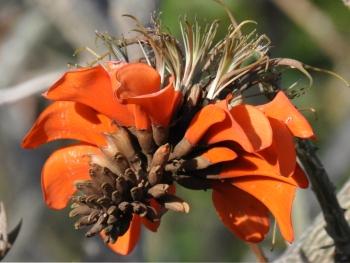
Description
Description
Erythrina afra is a medium- to large-sized deciduous tree, 9-12 x 7-11 m. Its size depends largely on the climate and soil conditions. This species forms a round-headed, spreading canopy and has a beautifully light green appearance when in leaf. Trees may even reach a height of 20 m in coastal and forested regions where the conditions are optimal. Some of the largest and most beautiful specimens grow in the Addo National Park's Alexandria Forest where, next to the yellowwoods, they are the tallest trees. The trunk and branches are grey, sometimes set with short, sharp prickles.

As with all other erythrinas, the leaves are typically trifoliate (three leaflets), which are broadly ovate (egg-shaped) to elliptic (oval and narrowed to rounded ends, widest at or about the middle), the terminal leaflet being the largest, 80-160 x 80-180 mm. The lateral leaves are slightly smaller and without hairs or prickles. The leaflet petiole (leaflet stalk) is up to 160 mm long and with or without prickles. The leaves closely resemble those of a sister species, E. lysistemon (sacred coral tree), which is why it was for many years thought to be the same species. When not in flower it can be rather difficult to tell the two species apart.

The flowers are spectacular and are produced before the leaves appear. They are carried in large clusters at the ends of thick, fleshy stalks. Superficially they are shaped like cockscombs. Flowering starts from winter and carries on throughout spring. The flower has a short, broad, standard petal, the lower half of which curves upward to expose the stamens, which give the flower a bewhiskered appearance. When compared to the flowers of E. lysistemon, the latter has longer, narrower standard petals which fold to enclose the stamens. There is also a difference in colour between E. lysistemon and E. afra. E. afra has mainly orange-scarlet flowers with a tinge of terracotta, in contrast to the clear scarlet of the northern species. There are also forms of E. afra which bear cream-coloured flowers occasionally seen in habitat.
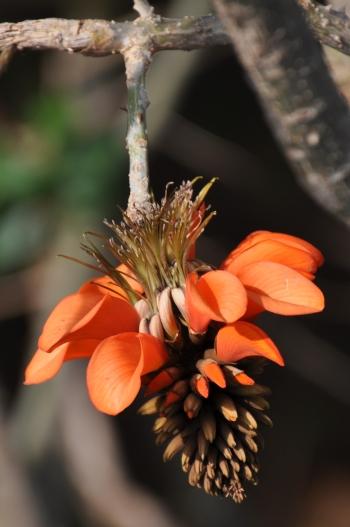
The fruits are dark, cylindrical pods, which are up to 65 mm long. The pods split to release the small, shiny, coral-red seeds, which are marked on one side with black spots. As seeds weather and become older, they turn a rich red-brown.
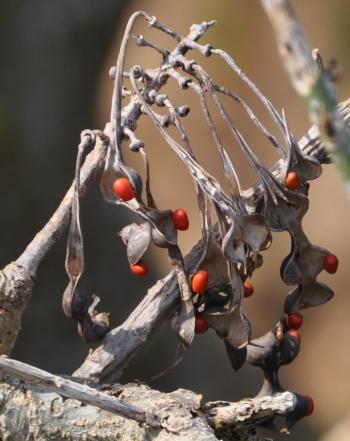
Conservation Status
Status
Erythrina afra occurs in coastal sheltered forests and along wooded rivers. It recruits very quickly from seeds, which birds carry across large distances. Although an important and well-used tree in rural areas, the coast coral tree is not endangered. Its ease of cultivation makes it readily available for garden use throughout the country.
Distribution and habitat
Distribution description
Erythrina afra is a subtropical tree that occurs in the warm and frost-free to light frost coastal regions of the Eastern Cape and northern KwaZulu-Natal. The trees are found in various soil types from wet, well-drained, humus-rich soils to dry, clayey soils. The distribution is from the Humansdorp district to Port Shepstone and inland to about 57 km into the Albany district of the Eastern Cape. Further north it is found in the Hlabisa and Lake Sibayi areas of Zululand where it is over 400 km away from its southern populations. This is quite a surprising distribution range.
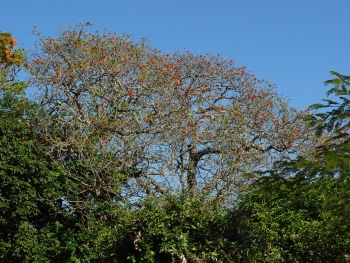
Derivation of name and historical aspects
History
The generic name Erythrina originates from the Greek word erythros which means red and alludes to the bright red flowers and seeds. The species name was previously caffra, a name derived from the Arabic word for an unbeliever, kafir, and the southeastern part of South Africa that is now the Eastern Cape was long ago known as Kaffraria, 'the land of the unbelievers'. Today this word is not used as it is an offensive slur. It was used in older botanical works, and generally indicates that the plant was found along the southeastern seaboard of South Africa. Carl Thunberg, who is also known as the father of South African botany, gave the name in 1770. Today the species name is afra, meaning, 'of Africa'.
The genus Erythrina is a group of shrubs and trees which have their origin not only in South Africa, but also the West Indies, Brazil, and Australia. The genus contains just over 170 species, 6 of which are found naturally in South Africa. These are Erythrina afra, E. lysistemon, E. latissima, E. humeana, E. acanthocarpa and E. zeyheri. The latter two are small to medium shrubs with thick, fleshy, underground stems and are more suitable as grouped plants or container plants in the garden. Three other species are found in southern Africa: E. decora, which is a small- to medium-sized tree that occurs in the central and northwestern region of Namibia, commonly known as the Kaokoveld; E. livingstoniana, which is also a medium to large tree but is found in Zimbabwe and Mozambique; and E. mendesii, which is a small shrub arising from an underground, branched stem and is found in the Kalahari sand in Botswana.
All South African erythrinas are noticeable and well established in cultivation primarily for their striking flowers. Most species in this genus have been loved by many different peoples since the early days of South African history. Their popularity also extends to gardens abroad, for example in the USA and Europe, where this species was cultivated under the name E. constantiana ( Mich.). It was also probably the first wild tree species planted in groups in the gardens of the Eastern Cape. A solitary coast coral tree near the present site of Port St. Johns figured in one of the very early Cape journals, that of Jacob van Reenen, whose party journeyed into the then unknown east in search of the wreck of the Grosvenor. The leader, Jan Andreis Holtshausen, who died of lockjaw, was buried under the tree on 24 November 1790. His friends carved their names upon its trunk.
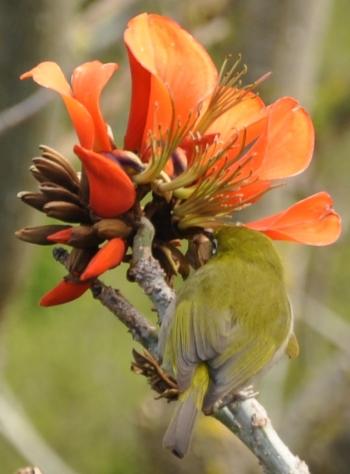
Ecology
Ecology
Both birds and flying insects pollinate coast coral trees. The flowers of Erythrina afra do not produce any fragrance, so it is only their colour, in combination with the reward of nectar which is produced in abundance, which attracts pollinators. Birds such as Red-winged Starlings (Onychocnathus morio), Bulbuls (Pycnonotus sp.), Eastern Golden Weavers (Ploceus subaureus), Sunbirds (Nectarinia sp.), Orioles (Orioles sp.), and many others feed on the nectar and red blossoms and can be seen by the hundreds visiting these trees in the early spring. The flowers appear before the leaves, and this may well be a strategy for visible advertising to attract as many nectar-feeding birds as possible. The shape and design of each flower are such that the stamens are exposed, resulting in easy pollen transfer by birds and insects. It is estimated that each flower may hold as many as 7-10 drops of nectar, and each flowerhead may hold up to 80 florets.
The red seeds are also an important food source for many seed-eating birds. Birds therefore not only pollinate the flowers but also aid in seed dispersal, which ultimately impacts on the natural distribution of the species throughout its entire habitat range. The seeds are also fed on by developing larvae of many winged beetles, which lay their small yellow eggs inside the immature pods. Borers also sometimes attack trees and do considerable damage, particularly to young trees. The dead wood of the coast coral tree is soft and is an ideal nesting place for birds such as the Pied Barbet (Tricholaema leucomelas) and Cardinal Woodpecker (Dendropicos fuscescens), while the hollow trunks are often inhabited by swarms of bees.
The branches are armed with prickles, which might serve as protection to herbivores especially when trees are still young. Fully grown trees are fairly drought resistant and can withstand several degrees of frost. In areas where there is severe frost, it may well grow but flowering is unlikely.
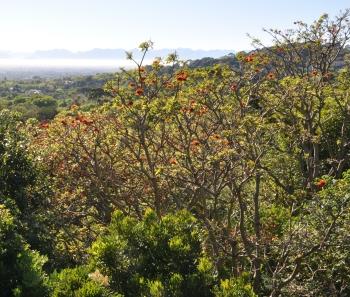
Uses
Use
In South Africa, Erythrina afra is seen as a royal tree: it is a much respected and admired tree in the Zulu culture and is believed to have magic properties. Specimens have been planted on the graves of many Zulu chiefs. In parts of the Eastern Cape, local inhabitants will not burn the wood of Erythrina afra for fear of attracting lightning.
Coast coral trees were also planted as living palisades around the houses of the early settlers, and used as fences around kraals and waterholes. In the Peddie District of the Eastern Cape there are a number of these living fences that have been closely planted around waterholes to keep livestock from the water or to channel them to the entrance.

The wood is very soft, spongy and light. Hollowed trunks were used to make canoes and troughs, and cubes of wood were used as floats for fishnets. When tarred, the wood made good roofing shingles. The African women of South Africa make the highly decorative seeds of Erythrina afra into necklaces. Children also love collecting them where they are known as lucky beans. All coral trees produce a poison with a curare-like and paralysing action, which is used medicinally to relax the muscles in treating nervous diseases. The seeds of all erythrinas are said to be poisonous, and the leaves of Erythrina afra are known to have poisoned cattle. The bark of E. afra is used topically to treat sores, wounds, abscesses and arthritis. Open wounds may be treated with powdered, burnt bark; infusions of the leaves are used as eardrops for earache; and decoctions of the roots are used for sprains. The Vhavenda use the bark for toothache. Erythrina alkaloids are known to be highly toxic, but the traditional uses strongly suggest antibacterial, anti-inflammatory and analgesic effects.
More common are the uses as a garden plant. These trees are admirably suited for park planting or to line streets of cities, small towns and villages. Fine specimens have been cultivated in Grahamstown and Graaff Reinet. In the Boland town of Worcester, there are beautiful specimens lining Tulbagh Street in the front section of the town. There is also a delightful avenue of them near Port St. Johns where they are a splendid sight when in full spring flower and alive with birds. On lawns they make beautiful specimens as single subjects, but one must be aware that in time these trees may become rather big and larger gardens would therefore be more suitable.
Growing Erythrina afra
Grow
As with all erythrinas, the coast coral tree is easily cultivated. Sow the bright red seeds in late spring or early summer (October or November). It is advisable to do a float test first to ascertain which seeds are viable. Sometimes seeds are parasitised by the larvae of beetles and other insects. Simply soak seeds in water, leave overnight and select only those that have sunk to the bottom. The water also helps to soften the hard seed coat so that germination takes place more easily. Another method used to aid germination is abrading, which involves the use of sandpaper or rough emery paper to remove part of the seed coat. Nicking is a modification of abrading and is done by simply removing a small section of the seed coat with a sharp knife. The end on the opposite side of the eye (the black spot on the seed) is removed to provide an opening for water to enter. The germination medium can be drenched with a long-acting pre-emergence fungicide such as Apron. This will help to prevent seed decay and seed-borne diseases, such as damping off, root rot and downy mildew on young seedlings. Pre-emergence fungicides are more commonly used to treat seeds that take a long time to germinate, and in the case of Erythrina afra this is more the exception than the rule. After germination, seedlings normally grow fast and might then contract fungal diseases. These should then be treated with systemic fungicides such as Fongarid. Poor drainage and over-watering enhance root rot problems caused by soil-borne fungal pathogens. It is also a good idea to drench the germination medium with boiling water before sowing. Use a well-drained medium consisting of 2 parts coarse, washed river sand and one part milled pine bark. Space seeds about 2-3 cm apart and do not cover too deeply; to about 0.3 cm is sufficient. Water well and store in a well-ventilated, sheltered area away from direct sunlight. Water seeds daily using a fine mist spray. Do not water late in the afternoon or early evening, as these are ideal times for fungus to develop.
Another effective and more instant propagation method is by making giant hardwood cuttings called truncheons. These are branches measuring at least 40 mm in diameter. This method works very well and cuttings must be taken just before the trees come out of dormancy which is late winter or early spring. After taking the cutting, allow the wound to dry for 1-2 days. Then bury one-third of the truncheon in soil while leaving two-thirds exposed to produce the new growth. Smaller cuttings root just as well. Again the same medium can be used as for germinating the seeds. Keep the bags or containers moist and store in a shaded place.
Erythrina afra should be planted in sunny places in well-drained soil. It can tolerate quite moist soils as it often grows on the banks of rivers and streams. The trees will also put up with dry conditions and poor soils; however, they do not respond well to excessively cold conditions. They can also be used in large rock gardens where the smaller species of coral trees e.g., Erythrina zeyeri (plough breaker), E. acanthocarpa (tambookei thorn), and E. humeana can be grown. The trees also provide ideal filtered shade for a host of herbaceous and perennial shrubs. Masses of Plectranthus eckloni, P. ciliatus, P. fruticosus can be planted in combination with purple and white Hypoestes aristata and Dissotis princeps. Other larger shrubs that can be planted with coast coral trees are Mackaya bella, Ochna serrulata, O. natalitia, Burchellia bubalina, Tetradenia riparia and Strelitzia reginae. To obtain multiple colours using bulbs underneath these spectacular trees, various options with different flowering periods are available. Good bulbous plants for mass planting include Scadoxus multiflorus subsp. Katharinae, which has orange flowers in autumn, Crinum moorei, with large, white pink bell-shaped flowers in autumn, Clivia miniata, with its brilliant orange flowers in spring, Dietes bicolor with bicoloured yellow and black flowers in summer, Crocosmia aurea with bright orange flowers in autumn, and Kniphofia praecox and K. uvaria which have beautifully contrasting yellow and orange flowers that appear in summer.
References
- Coates Palgrave, M. 2002. Keith Coates Palgrave Trees of southern Africa, edn 3. Struik, Cape Town.
- Germhuizen, G. & Meyer, N.L. (eds). 2003. Plants of southern Africa : an annotated checklist. Strelitzia 14. National Botanical Institute, Pretoria.
- Ginn, P.J., Mcilleron, W.G. & Milstein, P. 1996. The complete book of southern African birds. Struik, Cape Town.
- Hutchings, A. 1996. Zulu medicinal plants. University of Natal Press, CITY?.
- Jackson, W.P.U. 1990. Origins and meanings of South African plant genera. University of Cape Town Ecolab.
- Mason, H. 1972. Western Cape Sandveld flowers. Struik, Cape Town.
- Nichols, G. 2005. Growing rare plants. Southern African Biodiversity Network Report No. 36. SABONET, Pretoria.
- Palmer, E. & Eliovson, S. 1956. Flowering shrubs and trees for gardens in southern Africa. Howard Timmins, Cape Town.
- Pitman, N. 1972. Trees of southern Africa. Balkema., Cape Town.
- Stearn, W.T. 2003. Stearn's dictionary of plant names for the gardener. Cassel, London?
- Smith, C.A. 1966. Common names of South African plants. Memoirs of the Botanical Survey of South Africa No. 35.
- Van Jaarsveld, E. 2000. Waterwise indigenous gardening. Tafelberg, Cape Town.
- Van der Spuy, U. 1971. Ornamental shrubs and trees for gardens in southern Africa. Juta, Cape Town.
- Van Wyk, B. & Gericke, N. 2000. People's plants. Briza Publications, Pretoria.
Credits
Werner Voigt
Kirstenbosch NBG
October 2006
name updated May 2025
Plant Attributes:
Plant Type: Tree
SA Distribution: Eastern Cape, KwaZulu-Natal
Soil type: Sandy, Clay, Loam
Flowering season: Spring, Early Summer
PH: Acid, Alkaline, Neutral
Flower colour: Red, Orange
Aspect: Full Sun
Gardening skill: Easy
Special Features:
Horticultural zones











Rate this article
Article well written and informative
Rate this plant
Is this an interesting plant?
User Comments
Chris Jones, Portugal
April 02, 2018 at 2:55 PMPlease show a picture of the WHOLE tree! Just a few fragments give no idea of the overall effect of this tree in flower.
Login to add your Comment
Back to topNot registered yet? Click here to register.